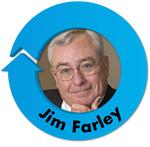 The big news out of the publishing business is that the venerable, old standby, The Atlantic, may be the first mainstream magazine to have generated more revenue from its digital assets than from traditional pages sold in October.
The big news out of the publishing business is that the venerable, old standby, The Atlantic, may be the first mainstream magazine to have generated more revenue from its digital assets than from traditional pages sold in October.
That’s a significant event, even for a magazine that typically sells at lower rates than some of its higher-priced competitors. If you consider that The Atlantic is 154 years-old, getting started around the time that Abraham Lincoln became the President, it’s even more impressive to see them succeed in the new media spotlight.
So how did this happen? Publisher Jay Lauf reports that back in 2008, digital accounted for only 9% of total ad sales. Working both TheAtlantic.com and The Atlantic Wire, their focus on digital has netted combined web visitors in the 6.7 million range. That’s inching closer to Time, and far surpasses The Daily Beast.
So it got me thinking. It is inevitable that in the next couple of years we’ll read in our industry trades that the same thing will happen to a radio brand here in the U.S. It may be hard to believe now, but a lean-forward station will ultimately generate more digital than broadcast spot dollars.
Who will it be? What will be the first set of call letters where digital ad revenue passes :30 and :60 spot sales?
My money’s on WTOP in Washington, D.C. As we’ve reported in this blog in the past, the Hubbard-owned institution in our nation’s capital has set all sorts of records as it has moved its content online, to streaming, on podcasts, videos, blogs, and social media.
Their Vice President of News and Programming, Jim Farley, will be telling WTOP’s story at our Summit on December 7.
Back in 2002, WTOP launched the first Internet station dedicated to serving federal employees and those interacting with the U.S. government. WTOP-2 became Federal News radio, and ultimately morphed into a broadcast station at 1500 AM (and also at 820 in Fredericksburg).
 In 2010 in an All Access interview, Farley discussed the 360° approach to radio that WTOP takes:
In 2010 in an All Access interview, Farley discussed the 360° approach to radio that WTOP takes:
“We see ourselves as a news organization informing and engaging as many people as possible, as often as possible, on FM Radio, HD Radio, streaming audio, a robust wtop.com, Facebook, Twitter, e-mail and text alerts and our free WTOP app. Right now the radio signal is our biggest megaphone, but hardly our only one. And the rate of growth is faster for digital than for radio in the long-term.”
So you can see why it was important to have Jim be part of this year’s Summit. He will be doing a presentation specific to WTOP as well as participating in a much-anticipated panel, “The Future of Content,” featuring Kurt Hanson as moderator. Farley will be joined by WMMR’s Bill Weston, KUT’s Hawk Mendenhall, futurist James Cridland, and Dial Global’s Beau Phillips.
As radio finds itself at another controversial crossroad when it comes to investing in content, this session promises to have plenty of meat on the bone.
Digital revenue and multi-platform content creation is an important conversation. Kudos to The Atlantic on a bona fide first.
Who in radio will be #1?
- What To Do If Your Radio Station Goes Through A Midlife Crisis - April 25, 2025
- A 2020 Lesson?It Could All Be Gone In A Flash - April 24, 2025
- How AI Can Give Radio Personalities More…PERSONALITY - April 23, 2025




“Who in radio will be #1?” No one…ever. Lets look at the numbers. Take a large market with 300 million in annual radio revenue. Now let’s look at a station with say, 5% of that market’s revenue, or $15 million. If you assume that the #1 digital revenue target is in addition to the terrestrial revenue (its of no real significance if its just moved one line item to another – more on that later), this first in digital station would have to generate over 15 million in digital revenue.
From what exactly? What radio originated digital offerings, past current or even imagined with the help of mind altering substances could possibly generate $15 million in annual revenue in a $300 million market? Where is this money going to come from? Websites with pictures of tracked DJs and remotes from two years ago? 250 average continuous streams? Imitation Groupon deals? In the words of Herman Cain, “…ain’t gonna happen!…”.
In pure media value, all of radio’s digital offerings put together may not be worth $15 million. If that’s true, how does radio report digital revenue in the (still insignificant but much higher) heavy hundreds of millions? Get a few DOS’ and GSMs good and drunk and I’ll be they would tell you that its mostly from moving money around – the time honored practice of charging for what they’re pressured to sell (digital) and bonusing what the advertiser really wants (terrestrial) so that it looks to their management and Wall Street analysts that they’re selling digital assets. There is some good news here – terrestrial radio is probably growing a bit faster than the published numbers indicate – because a good portion of the digital revenue they report is probably really terrestrial.
Radio doesn’t really have/offer digital assets with much media value. Don’t get me wrong – I agree with and applaud Jacobs Media’s encouragement of reaching LISTENERS digitally. It’s where they are how they communicate – and why Facebook, Twitter, YouTube and Foursquare are generating the revenue they are. While radio is wise to use and leverage those media, it doesn’t own them or anything like them – so they represent an important opportunity for talking to and bonding with listeners, but not a direct revenue source.
IMO, radio’s digital and overall future lies in streaming and its natural outgrowth. Radio should be fighting the music industry tooth and nail for major changes in the current streaming royalty structure and not worrying about how many ad banners its beleaguered sales people can pretend to sell. And fighting with everything they have as if their survival depends on it.
Because it does…
It’s a long road, to be sure, but I’m not saying “never.” Radio has a checkered history in this space, and you (as always) make some good points, Bob. Without a commitment to great content, this can’t possibly happen. But I believe there are brands that have the capability to get there – and WTOP is one of them. I look at the results of podcast downloads on iTunes for public radio shows and it tells me that if radio offers great programming in a digital anywhere/anytime format – and we have the right account reps selling this asset – our ability to attract audiences well beyond our metros is possible.
And I agree totally about the stream. It’s our future, but right now in the present, radio’s streaming assets are so back-burnered that programmers and managers rarely think about them. As Pandora, Spotify, and other Internet operators grow, as WiFi becomes the norm, and as the dashboards on our vehicles are modernized, this is where it will be at – or is at right now. I really appreciate you taking the time to chime in, Bob.